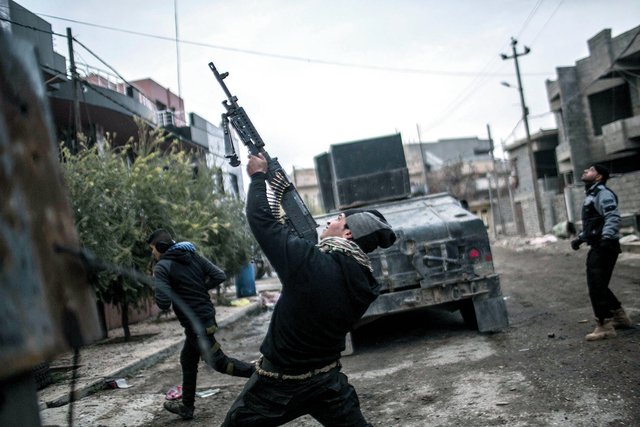MOSUL, Iraq — Iraqi forces stalled for weeks on the edges of Mosul are being bolstered by reinforcements and now are ready, along with elite special forces, to launch a stepped up, three-pronged assault against Islamic State militants in the
MOSUL, Iraq — Iraqi forces stalled for weeks on the edges of Mosul are being bolstered by reinforcements and now are ready, along with elite special forces, to launch a stepped up, three-pronged assault against Islamic State militants in the city’s eastern sector, ending a two-week lull in fighting, a top Iraqi general told the Associated Press.
The planned assault aims in part to overcome stiff resistance by the militants that has slowed advances in the more than 2-month-old offensive to recapture the northern city, the last main bastion of the Islamic State group in Iraq.
In an attempt to isolate militants in the eastern sector from those in the western half of Mosul, warplanes from the U.S.-led coalition destroyed the last remaining bridge over the Tigris River, which runs through city center.
So far in the Mosul offensive, Iraq’s counterterrorism forces, which are by far the military’s most battle seasoned unit, have done most of the fighting, pushing in from the east. But regular army troops on the city’s southeast and northern edges, as well as federal police farther west, have not moved in weeks, unable to penetrate the city either because they are not equipped or trained to fight on the streets or because of inadequate resources.
Lt. Gen. Abdul-Wahab al-Saadi, commander of the counterterrorism forces in eastern Mosul, said in an interview Tuesday night that units of the federal police have joined units from the military’s 9th Division southeast of Mosul, while troops have taken positions alongside units from the army’s 16th Division on the north side.
Al-Saadi would not say when the advance would begin. But it appeared likely within days, weather permitting. He would not give details on the size of the reinforcements.
The new reinforcements suggest that original plans to penetrate the city’s western side have been abandoned and that the plan was now for all forces to push on in the eastern sector.
The bridge hit this week was the last remaining of five bridges across the Tigris between the western and eastern halves. Activists inside Mosul published photos Tuesday night showing the twisted girders of the bridge in the water as boats ferried residents back and forth. The Old Bridge, as it is known, was built in the 1930s and is considered one of the city’s iconic landmarks.
The damage is expected to further complicate life inside Mosul. A resident said people waiting by the banks to be ferried across ran for cover every time they heard a plane buzzing overheard, fearing further airstrikes.
The counterterrorism forces, also known as the “Golden Division,” have taken a string of neighborhoods in eastern Mosul and are now less than 3 kilometers (2 miles) away from the Tigris River, which slices the city in half. But they have moved little the past two weeks, apparently waiting for the reinforcements.
They have faced grueling urban fighting, often house to house against IS militants who have had more than two years to dig in and prepare. Even in districts that have been wrested away from IS, Iraqi troops have faced surprise attacks, shelling and car bombs. The extremists have launched more than 900 car bombs against Iraqi troops so far during the operation in Mosul and surrounding areas in Nineveh province. Al-Saadi said 260 of these targeted his men.
“Daesh has by now realized that the battle is in the eastern sector of Mosul, and that’s where most of its forces are,” said al-Saadi, using an Arabic acronym for the Islamic State group.
He denied reports that the lull in fighting was caused by a higher-than-expected casualties among his men. “We have sustained casualties, but not much,” he said. “We will also be reinforced by new members of the counterterrorism forces,” he said, without elaborating.
The presence of an estimated one million civilians inside Mosul is partly to blame for the slow progress in the battle since Iraqi forces and their allies in the U.S.-led coalition have avoided the use of overwhelming firepower against the militants for fear of massive civilian casualties. About 120,000 people have fled the city since the offensive began, according to the United Nations.
“Daesh snipers shoot at us from the rooftops of homes occupied by families. We can only use light arms against them so as not to hurt the civilians,” he explained. “They fire from side streets lined by homes. Again, we can only use light arms.”
A new menace in the fight was the growing use by IS of drones, mostly armed with bombs or grenades that they drop on troops or civilians, he said.
Al-Saadi said he expected Mosul and the rest of Nineveh province to be totally rid of IS in about three months.
Prime Minister Haider al-Abadi spoke last week of a need to revise the battle plans in Mosul. On Tuesday, he told a news conference: “God willing, there will be good news in the coming days,” he said.



